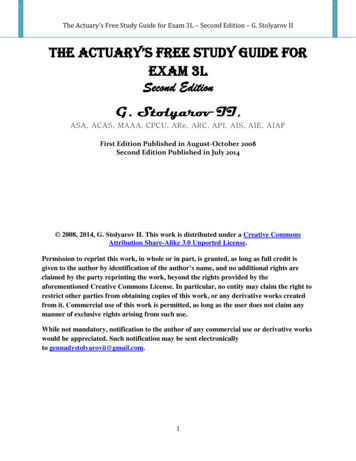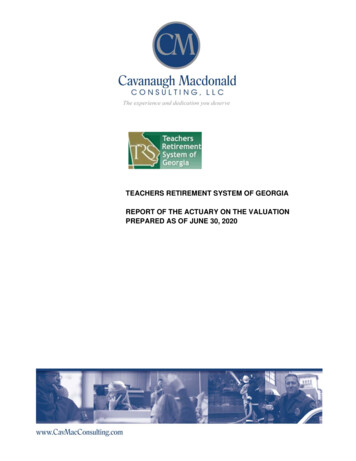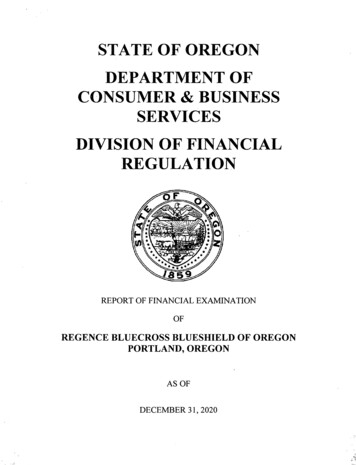
Transcription
The Actuary’s Free Study Guide for Exam 3L – Second Edition – G. Stolyarov IIThe Actuary’s Free Study Guide forExam 3LSecond EditionG. Stolyarov II,ASA, ACAS, MAAA, CPCU, ARe, ARC, API, AIS, AIE, AIAFFirst Edition Published in August-October 2008Second Edition Published in July 2014 2008, 2014, G. Stolyarov II. This work is distributed under a Creative CommonsAttribution Share-Alike 3.0 Unported License.Permission to reprint this work, in whole or in part, is granted, as long as full credit isgiven to the author by identification of the author’s name, and no additional rights areclaimed by the party reprinting the work, beyond the rights provided by theaforementioned Creative Commons License. In particular, no entity may claim the right torestrict other parties from obtaining copies of this work, or any derivative works createdfrom it. Commercial use of this work is permitted, as long as the user does not claim anymanner of exclusive rights arising from such use.While not mandatory, notification to the author of any commercial use or derivative workswould be appreciated. Such notification may be sent electronicallyto gennadystolyarovii@gmail.com.1
The Actuary’s Free Study Guide for Exam 3L – Second Edition – G. Stolyarov IITable of ContentsSectionSection 1: Life-Table Probability Functions: Practice Problems and Solutions – Part 1Section 2: Life-Table Probability Functions: Practice Problems and Solutions – Part 2Section 3: Curate-Future-LifetimeSection 4: Force of MortalitySection 5: Identities Involving Life Table Functions and Force of MortalitySection 6: Life-Table Probability Functions: Practice Problems and Solutions – Part 3Section 7: Life-Table Probability Functions: Practice Problems and Solutions – Part 4Section 8: Deterministic Survivorship GroupsSection 9: Computing Expected Values for Continuous Random VariablesSection 10: Complete-Expectation-of-LifeSection 11: Median Future LifetimeSection 12: Computing Expected Values for Discrete Random VariablesSection 13: Life-Table Probability Functions: Practice Problems and Solutions – Part 5Section 14: Life-Table Probability Functions: Practice Problems and Solutions – Part 6Section 15: The Uniform-Distribution-of-Deaths Assumption for Fractional AgesSection 16: The Uniform-Distribution-of-Deaths Assumption for Fractional Ages: PracticeProblems and Solutions – Part 2Section 17: Exam-Style Questions on Life-Table Functions – Part 1Section 18: Exam-Style Questions on Life-Table Functions – Part 2Section 19: Temporary Complete Life ExpectancySection 20: Recursion FormulasSection 21: Term Life InsuranceSection 22: Moments of the Present Value of a Term Life Insurance PolicySection 23: Whole Life InsuranceSection 24: Makeham's Law of MortalitySection 25: Weibull's Law of MortalitySection 26: Probability Density Functions and Cumulative Distribution Functions of PresentValue Random VariablesSection 27: Pure EndowmentsSection 28: Endowment InsuranceSection 29: Deferred Life InsuranceSection 30: Annually Increasing Whole Life InsuranceSection 31: Continuously Increasing Whole Life InsuranceSection 32: Annually Decreasing Term Life InsuranceSection 33: Insurances Payable at the End of the Year of DeathSection 34: Whole Life Insurance Payable at the End of the Year of DeathSection 35: Endowment Insurance Payable at the End of the Year of DeathSection 36: Exam-Style Questions on Life Insurance PoliciesSection 37: Continuous Whole and Temporary Life AnnuitiesSection 38: Variances and Relationships Among Present Values of Continuous Whole andTemporary Life AnnuitiesSection 39: Continuous Deferred Life Annuities and Certain and Life AnnuitiesSection 40: Actuarial Accumulated Values and Derivatives of Actuarial Present Values ofContinuous Life AnnuitiesSection 41: Discrete Whole Life 9515457606365687176808488929598101105108111115117
The Actuary’s Free Study Guide for Exam 3L – Second Edition – G. Stolyarov IISection 42: Discrete Temporary Life AnnuitiesSection 43: Discrete Deferred Life Annuities and Certain and Life AnnuitiesSection 44: The Equivalence Principle and Fully Continuous Benefit Premiums for Whole,Term, and Endowment Life Insurance PoliciesSection 45: Fully Continuous Benefit Premiums for Pure Endowments and Exam-StyleQuestions on Life Insurance and Life AnnuitiesSection 46: Exam Style Questions on Life Table Functions for Independent Lives and MultipleCauses of DecrementSection 47: The Pareto and Weibull Probability DistributionsSection 48: The Negative Binomial Distribution and Some Associated Mixture DistributionsSection 49: The Lognormal Probability Distribution, Markov Chains, and Assorted Exam-StyleQuestionsSection 50: Probability Generating Functions, Poisson Processes, and Assorted Exam-StyleQuestionsSection 51: Binomial, Pareto, and Compound Probability DistributionsSection 52: Fully Discrete Benefit Premiums, Infinite Divisibility Property for Some ProbabilityDistributions, and Assorted Exam-Style QuestionsSection 53: Order Statistics, Likelihood Functions, and Maximum Likelihood EstimatesSection 54: Exam-Style Questions on the Method of Moments, Significance Levels, and theNeyman-Pearson LemmaSection 55: Chi-Square Goodness-of-Fit TestSection 56: Hypothesis Testing: Type I and Type II Errors, P-Values, and the Student-tDistributionSection 57: Least-Squares Regression and Assorted Exam-Style QuestionsSection 58: Fully Discrete Benefit ReservesSection 59: The Central Limit Theorem and the Continuity Correction for NormalApproximationsSection 60: Characteristics of Estimators, Mean Square Error, and Assorted Exam StyleQuestionsSection 61: Residuals in Linear Regression and Assorted Exam-Style QuestionsSection 62: Assorted Exam-Style Questions on Compound Poisson Processes, NormalApproximations, Force of Mortality, and Multiple Forces of DecrementSection 63: Exam-Style Questions on Markov Chains and Percentile CalculationsSection 64: Poisson Processes and the Gamma DistributionSection 65: The F Distribution and Hypothesis Testing of VariancesSection 66: Joint-Life Status and Last-Survivor StatusSection 67: Assorted Exam-Style Review Questions for Actuarial Exam 3LSection 68: Challenging Exam-Style Review Questions for Actuarial Exam 3LSection 69: Exam-Style Questions for Actuarial Exam 3L – Part 3Section 70: Pooled Sample Variances and Covariances for Multiple-Life StatusesSection 71: The Coefficient of Determination in Linear Regression, Fully Continuous BenefitReserves Under DeMoivre's Law, and Assorted Exam-Style QuestionsSection 72: Chi-Square Test for the Variance and Assorted Exam-Style QuestionsSection 73: Exam-Style Questions for Actuarial Exam 3L – Part 4Section 74: Exam-Style Questions for Actuarial Exam 3L – Part 5Section 75: Exam-Style Questions for Actuarial Exam 3L – Part 6Section 76: Exam-Style Questions for Actuarial Exam 3L – Part 7Section 77: Exam-Style Questions for Actuarial Exam 3L – Part 8About Mr. 230234238240243246248
The Actuary’s Free Study Guide for Exam 3L – Second Edition – G. Stolyarov IISection 1Life-Table Probability Functions: PracticeProblems and Solutions – Part 1Before we begin to explore various life-table functions, some actuarial notation is in order.(x) refers to a life of age x.T(x) refers to the future lifetime of a life currently at age x.X refers to the age of death of a particular life.F(x) is the cumulative distribution function of X.s(x) is the survival function of X.The following are true of F(x) and s(x):F(x) Pr(X x), x 0.s(x) 1 - F(x) Pr(X x), x 0.It is always assumed in these models that F(0) 0 and s(0) 1.The following two expressions are particularly important in studying life tables.tqxis the probability that life (x) will die within t years. It can also be expressed astqx Pr(T(x) t), t 0.tpxis the probability that life (x) will survive during the next t years and reach the age x t.It can also be expressed astpx 1 - t q x Pr(T(x) t), t 0.When a life's current age is zero, x p 0 s(x), x 0.When t 1, we can omit the "t" subscript to the left of the "p" or the "q." Thus,q x is the probability that life (x) will die within 1 year.p x is the probability that life (x) will survive during the next 1 year and reach the age x 1.4
The Actuary’s Free Study Guide for Exam 3L – Second Edition – G. Stolyarov IIHere are some convenient ways of calculating t p x and t q x .tpx s(x t)/s(x)t q x 1 - s(x t)/s(x)The above calculations will be the focus of this section, as it is vital to be able to do them inorder to move on to understanding other concepts relevant to Exam 3L.Source: Bowers, Gerber, et. al. Actuarial Mathematics. 1986. First Edition. Society of Actuaries:Itasca, Illinois. pp. 45-48.Problem S3L1-1. The life of a triceratops has the following survival function associated with it:s(x) e-0.34x. Find 3 p 5 .Solution S3L1-1. We use the formula t p x s(x t)/s(x). Thus, 3 p 5 s(5 3)/s(5) s(8)/s(5) e-0.34*8/e-0.34*5 e-0.34*3 3 p 5 e-1.02 0.3605949402Problem S3L1-2. The life of a giant pin-striped cockroach has the following survival functionassociated with it: s(x) 1 - x/94, for 0 x 94 and 0 otherwise. Find 55 q 34 .Solution S3L1-2. We use the formula t q x 1 - s(x t)/s(x). Thus, 55 q 34 1 - s(55 34)/s(34) 1 - s(89)/s(34) 1 - (1 - 89/94)/(1 - 34/94) 55 q 34 11/12 about 0.916666666667Problem S3L1-3. Three-headed donkeys always survive until age 1. Thereafter, the survivalfunction for the life of a three-headed donkey is s(x) 1/x for all x 1. What is the probabilitythat a three-headed donkey that has survived to age 65 will survive to age 68?Solution S3L1-3. We wish to find 3 p 65 s(65 3)/s(65) (1/68)/(1/65) 3 p 65 65/68 about0.9558823529.Problem S3L1-4. Black swans always survive until age 16. After age 16, the lifetime of a blackswan can be modeled by the cumulative distribution function F(x) 1 - 4x-1/2, x 16. What is theprobability that a black swan that has survived to age 33 will survive to age 34?Solution S3L1-4. We seek to find p 33 s(33 1)/s(33) s(34)/s(33). We know that s(x) 1 F(x) 1- (1 - 4x-1/2) 4x-1/2. Thus, s(34)/s(33) (4*34-1/2)/(4*33-1/2) p 33 (33/34) 0.9851843661.Problem S3L1-5. The lives of Unicorn-Pegasi can be modeled by the following cumulativedistribution function: F(x) x/36 - e-0.45x. If any Unicorn-Pegasus reaches the age of 35, it willget to live forever. Find the probability that a Unicorn-Pegasus currently aged 34 will not get tolive forever.Solution S3L1-5. We wish to find q 34 , the probability that the Unicorn-Pegasus aged 34 will diewithin 1 year. We use the formula t q x 1 - s(x t)/s(x). Here, s(x) 1 - F(x) 1 - x/36 e-0.45x.q 34 1 - s(35)/s(34) 1 - (1 - 35/36 e-0.45*35)/(1 - 34/36 e-0.45*34) about 0.4999994386.5
The Actuary’s Free Study Guide for Exam 3L – Second Edition – G. Stolyarov IISection 2Life-Table Probability Functions: PracticeProblems and Solutions – Part 2Here, we introduce another life-table probability function.t u q x is the probability that life (x) will survive for the next t years and die within thesubsequent u years. That is, t u q x is the probability that life (x) will die between ages x tand x t u.When u 1, this function can simply be written ast q x .Other expressions for t u q x are as follows:t u q x Pr[t T(x) t u]t u q x t u q xt u q x t p x- tqx- t upxWe can calculate t u q x as follows:t u q x (s(x t) - s(x t u))/s(x) t p x * u q x tSource: Bowers, Gerber, et. al. Actuarial Mathematics. 1986. First Edition. Society of Actuaries:Itasca, Illinois. pp. 47-48.Original Problems and Solutions from The Actuary's Free Study GuideProblem S3L2-1. The life of a triceratops has the following survival function associated with it:s(x) e-0.34x. Find 6 4 q 2 .Solution S3L2-1. We use the following formula:t u q x (s(x t) - s(x t u))/s(x).Thus,q 2 (s(2 6) - s(2 6 4))/s(2) (s(8) - s(12))/s(2) (e-0.34*8 - e-0.34*12)/(e-0.34*2) 6 4 q 2 about 0.0966554096 4Problem S3L2-2. The life of a giant pin-striped cockroach has the following survival functionassociated with it: s(x) 1 - x/94, for 0 x 94 and 0 otherwise. Find 5 5 q 22 .Solution S3L2-2. We use the following formula:6t u q x (s(x t) - s(x t u))/s(x).Thus,
The Actuary’s Free Study Guide for Exam 3L – Second Edition – G. Stolyarov II5 5 q 22 (s(22 5) - s(22 5 5))/s(22) (s(27) - s(32))/s(22) ((1 - 27/94) - (1 - 32/94))/(1 22/94) (5/94)/(72/94) 5 5 q 22 5/72 about 0.0694444444444Problem S3L2-3. Three-headed donkeys always survive until age 1. Thereafter, the survivalfunction for the life of a three-headed donkey is s(x) 1/x for all x 1. What is the probabilitythat a three-headed donkey that has survived to age 23 will senselessly perish (i.e., die) betweenthe ages of 45 and 69?Solution S3L2-3. We wish to find 22 24 q 23 (s(45) - s(69))/s(23) (1/45 - 1/69)/(1/23) 22 24 q 23 8/45 about 0.17777777778Problem S3L1-4. You know the following about the lives of jumping slugs. For a jumping slugthat has survived to age 39, the probability of surviving to age 45 is 0.835. For a jumping slugthat has survived to age 45, the probability of dying within the subsequent 8 years is 0.23. Whatis the probability that a jumping slug that has survived to age 39 will senselessly perish (i.e., die)between the ages of 45 and 53?Solution S3L1-4. We use the following formula: t u q x t p x * u q x t . We wish to find 6 8 q 39 6 p 39 * 8 q 45 , where we are given that 6 p 39 0.835 and 8 q 45 0.23. Thus, 0.835*0.23 6 8 q 39 0.19205Problem S3L1-5. There is a 0.05 probability that an ancient Greek god who has survived to age1245 will die between the ages of 1298 and 1403. Zeus is currently 1245 years old, and hisprobability of surviving to age 1298 is 0.95. What is the probability that, if Zeus survives to age1298, he will also survive past age 1403?Solution S3L1-5. We use the following formula: t u q x t p x * u q x t . We wish to findWe are given that 53 105 q 1245 0.05 and 1298 p 1245 0.95. We thus know that 0.05 0.95* 105 q 1298 , and so 105 q 1298 1/19. 1- 105 q 1298 105 p 1298 18/19 0.05263157897105 p 1298 .
The Actuary’s Free Study Guide for Exam 3L – Second Edition – G. Stolyarov IISection 3Curate-Future-LifetimeThe curate-future-lifetime of life (x) is the number of future years that life (x) completes beforedeath. The curate-future-lifetime of (x) is represented by the random variable K(x).The probability density function of K(x) can be expressed in the following ways:Pr[K(x) k] Pr[k T(x) k 1]Pr[K(x) k] k p x -k 1 p xPr[K(x) k] k p x *q x kPr[K(x) k] k q xfor all nonnegative integer values of k.The cumulative distribution function of K(x) can be expressed as follows:Pr[K(x) k] k 1 q x for all nonnegative integer values of k.Source: Bowers, Gerber, et. al. Actuarial Mathematics. 1986. First Edition. Society of Actuaries:Itasca, Illinois. p. 48.Original Problems and Solutions from The Actuary's Free Study GuideProblem S3L3-1. The life of a triceratops has the following survival function associated with it:s(x) e-0.34x. Find the probability that the curate-future-lifetime of a triceratops life (34) is 7years.Solution S3L3-1. We want to find Pr[K(34) 7].We use the formula Pr[K(x) k] k q x . In this case,7 q 34 (s(34 7) - s(34 7 1))/s(34) (s(41) - s(42))/s(34) (e-0.34*41 - e-0.34*42)/(e-0.34*34) Pr[K(34) 7] 0.0266758231Problem S3L3-2. Every year, 0.26 of the lemming population senselessly perishes (i.e., dies),and every lemming has the same likelihood of senselessly perishing. Find the probability that thecurate-future-lifetime of a lemming currently aged 3 is 2 years.Solution S3L3-2. We use the formula Pr[K(x) k] k p x - k 1 p x . We want to find Pr[K(3) 2].Thus, we need to find 2 p 3 and 3 p 3 . The probability of a lemming of any age surviving two moreyears is8
The Actuary’s Free Study Guide for Exam 3L – Second Edition – G. Stolyarov II(1 - 0.26)2 0.5476 so 2 p 3 0.5476. The probability of a lemming of any age surviving threemore years is (1 - 0.26)3 0.405224 so 3 p 3 0.405224. Thus, Pr[K(3) 2] 2 p 3 - 3 p 3 0.5476 0.405224 0.142376Problem S3L3-3. The life of a giant pin-striped cockroach has the following survival functionassociated with it: s(x) 1 - x/94, for 0 x 94 and 0 otherwise. Find the cumulativedistribution function of the curate-future-lifetime of life (36). Use k as your only variable.Solution S3L3-3. The cumulative distribution function of K(36) can be expressed as follows:Pr[K(36) k] k 1 q 36 . We recall from Section 1 that t q x 1 - s(x t)/s(x) and sok 1 q 36 1 - s(37 k)/s(36) 1 - (1 - (37 k)/94)/(1 - 36/94) 1 - ((94 - 37 - k)/94)/(58/94) 1 - (57 - k)/58 (58 - 57 k)/58 Pr[K(36) k] (1 k)/58Problem S3L3-4. For white elephants, the probability that the curate-future-lifetime of life (123)is 4 years is 0.536. The probability that a white elephant that has survived for 127 years willsurvive for another year is 0.356. Find the probability that a white elephant that has survived for123 years will survive to age 127.Solution S3L3-4. We use the formula Pr[K(x) k] k p x *q x k . We are given that Pr[K(123) 4]is 0.536 and that p 127 is 0.356. We can quickly find q 127 1 - 0.356 0.644. Our goal is to find4 p 123 . By the formula above, 4 p 123 Pr[K(123) 4]/q 127 0.536/0.644 4 p 123 0.8322981366.Problem S3L3-5. Three-headed donkeys always survive until age 1. Thereafter, the survivalfunction for the life of a three-headed donkey is s(x) 1/x for all x 1. Eight-tailed oxen alsoalways survive until age 1. Thereafter, the survival function for the life of an eight-tailed ox is1/x2 for all x 1. Find the probability that the curate-future-lifetime of a three-headed donkeylife (3) is 5 years and that the curate-future-lifetime of an eight-tailed ox life (3) is 5 years.Solution S3L3-5.For three-headed donkeys, Pr[K(3) 5] 5 q 3 (s(8) - s(9))/s(3) (1/8 - 1/9)/(1/3) 1/24For eight-tailed oxen, Pr[K(3) 5] 5 q 3 (s(8) - s(9))/s(3) (1/82 - 1/92)/(1/32) 17/576To get the probability that both of these curate-future-lifetimes are 5 years, we multiply theindividual probabilities and obtain our desired answer: (1/24)(17/576) 17/13824 about0.0012297454.9
The Actuary’s Free Study Guide for Exam 3L – Second Edition – G. Stolyarov IISection 4Force of MortalityThis section will explore the force of mortality, alternatively known as the failure rate or thehazard rate function. It is abbreviated as μ x . The force of mortality describes an "instantaneousrate of death" and can be found via the following formulas:μ x f(x)/(1 - F(x))μ x -s'(x)/s(x)The force of mortality is always greater than or equal to zero, since s(x) is always nonnegativeand its derivative, s'(x), is always non-positive, so -s'(x) is always nonnegative.Meaning of Terms:X refers to the age of death of a particular life.F(x) is the cumulative distribution function of X.s(x) is the survival function of X.f(x) is the probability density function of X.Source: Bowers, Gerber, et. al. Actuarial Mathematics. 1986. First Edition. Society of Actuaries:Itasca, Illinois. p. 48-49.Original Problems and Solutions from The Actuary's Free Study GuideProblem S3L4-1. The life of a triceratops has the following survival function associated with it:s(x) e-0.34x. Find μ x .Solution S3L4-1. We use the formula μ x -s'(x)/s(x). Since s(x) e-0.34x, it follows thats'(x) -0.34e-0.34x and so μ x (0.34e-0.34x)/(e-0.34x) μ x 0.34Problem S3L4-2. The life of a giant pin-striped cockroach has the following survival functionassociated with it: s(x) 1 - x/94, for 0 x 94 and 0 otherwise. Find μ x .Solution S3L4-2. We use the formula μ x -s'(x)/s(x). Since s(x) 1 - x/94, it follows thats'(x) -1/94 and so μ x (1/94)/(1 - x/94) (1/94)/((94 - x)/94) μ x 1/(94 - x)10
The Actuary’s Free Study Guide for Exam 3L – Second Edition – G. Stolyarov IIProblem S3L4-3. Three-headed donkeys always survive until age 1. Thereafter, the survivalfunction for the life of a three-headed donkey is s(x) 1/x for all x 1. What is the force ofmortality for three-headed donkeys? Warning: Make sure you examine all possible ages!Solution S3L4-3. Prior to age 1, no three-headed donkeys die, so the force of mortality is 0. (Wecan confirm this by recognizing that s(x) is 1 for x 1 and so s'(x) 0 and thus μ x 0).After age 1, s(x) is 1/x, so s'(x) -1/x2. We now apply the formula μ x -s'(x)/s(x) (1/x2)/(1/x) x/x2 μ x 1/x.Thus, μ x 0, for 0 x 1 and μ x 1/x for x 1.Problem S3L4-4. Black swans always survive until age 16. After age 16, the lifetime of a blackswan can be modeled by the cumulative distribution function F(x) 1 - 4x-1/2, x 16. What is theforce of mortality for black swans? Warning: Make sure you examine all possible ages!Solution S3L4-4. Prior to age 16, no black swans die, so the force of mortality for x 16 is 0.After age 16, F(x) 1 - 4x-1/2, and f(x) F'(x) (-1/2)(-4)x-3/2 f(x) 2x-3/2. So we can use theformula μ x f(x)/(1 - F(x)) (2x-3/2)/(4x-1/2) 1/(2x).Thus, μ x 0, for 0 x 16 and μ x 1/(2x) for x 16.Problem S3L4-5. The lives of Unicorn-Pegasi can be modeled by the following cumulativedistribution function: F(x) x/36 - e-0.45x. If any Unicorn-Pegasus reaches the age of 35, it willget to live forever. What is the force of mortality for Unicorn-Pegasi? Warning: Make sure youexamine all possible ages!Solution S3L4-5. For all x 35, Unicorn-Pegasi are still mortal. It is given that F(x) x/36 - e, and so f(x) F'(x) 1/36 0.45e-0.45x. So we can use the formula0.45xμ x f(x)/(1 - F(x)) (1/36 0.45e-0.45x)/(1 - x/36 e-0.45x) (1 16.2e-0.45x)/(36 - x 36e-0.45x).After reaching age 35, Unicorn-Pegasi no longer die, so their force of mortality becomes 0.Thus, μ x (1 16.2e-0.45x)/(36 - x 36e-0.45x), for 0 x 35 and μ x 0 for x 35.11
The Actuary’s Free Study Guide for Exam 3L – Second Edition – G. Stolyarov IISection 5Identities Involving Life Table Functions andForce of MortalityHere, we will explore several useful relationships between the force of mortality, discussed inSection 4, and various life table functions:npx exp(- x x n μ y dy)npx exp(- 0 n μ x s ds), where s y - x.xp0 s(x) exp(- 0 x μ s ds)F'(x) f(x) x p 0 *μ xd(1 - t p x )/dt -d( t p x )/dt t p x μ x tMeaning of Terms:X refers to the age of death of a particular life.F(x) is the cumulative distribution function of X.s(x) is the survival function of X.f(x) is the probability density function of X.tpxis the probability that life (x) will survive during the next t years and reach the age x t.μ x is the force of mortality for life (x).Source: Bowers, Gerber, et. al. Actuarial Mathematics. 1986. First Edition. Society of Actuaries:Itasca, Illinois. p. 49-50.Original Problems and Solutions from The Actuary's Free Study GuideProblem S3L5-1. Tyrannosaurs have a force of mortality μ y 1/y2. Find12 p 34for tyrannosaurs.Solution S3L5-1. We can let n 12 and x 34 and use the formulanpx exp(- x x n μ y dy) exp(- 34 46 (1/y2)dy) exp(-0.0076726343) 12 p 34 0.9923567253.12
The Actuary’s Free Study Guide for Exam 3L – Second Edition – G. Stolyarov IIProblem S3L5-2. The force of mortality for octahedral armadillos is μ s 0 for s 1 and 1/(95s)for s 1. What is the survival function for octahedral armadillos?Solution S3L5-2. Since the force of mortality is 0 for s 1, it follows from this that s(x) 1 forx 1.For x 1, we use the formula s(x) exp(- 1 x μ s ds) exp(- 1 x 1/(95s)ds) exp(-ln(s)/95 1 x) exp(-ln(x)/95 ln(1)/95) exp(-ln(x)/95 0/95) exp(-ln(x)/95) exp(ln(x-1/95)) s(x) x-1/95.Thus, s(x) 1 for x 1 and s(x) x-1/95 for x 1.Problem S3L5-3. The force of mortality for octahedral armadillos is μ s 0 for s 1 and 1/(95s)for s 1. What is the probability density function for the lives of octahedral armadillos?Solution S3L5-3. We use the formula f(x) x p 0 *μ x . We are given that μ s 0 for s 1, so f(x) isalso 0 for s 1. From Solution S3L5-2, we know that x p 1 , the survival function for x 1, is x1/95.Also, we know that for x 1, μ x 1/(95x). Thus, we have f(x) x-1/95*1/(95x) (1/95)x-1/96.Therefore, f(x) 0 for x 1 and f(x) (1/95)x-1/96 for x 1.Problem S3L5-4. Tyrannosaurs have a force of mortality μ y 1/y2. Find -d( 32 p 56 )/dt fortyrannosaurs.Solution S3L5-4. We use the formula -d( t p x )/dt t p x μ x t for x 56 and t 32. Thus, we need tofind μ 88 1/882 and 32 p 56 exp(- 56 88 (1/y2)dy) exp(-0.0064935065) 0.9935275308. So d( t p x )/dt 0.9935275308/882 about 0.000128296427Problem S3L5-5. For orange rabbits, 18 p 12 0.836, and μ y has the form 1/(k - y). Find k.Solution S3L5-5. We use the formula n p x exp(- x x n μ y dy), which in this particular casetranslates to3018 p 12 0.836 exp(- 12 (1/(k - y)dy). Thus,0.836 exp(ln(k - y) 12 30)0.836 exp(ln(k - 30) - ln(k - 12))0.836 exp(ln[(k-30)/(k-12)])0.836 (k-30)/(k-12)0.836(k-12) (k-30)0.836k - 10.032 k - 3019.968 0.164kk 121.756097613
The Actuary’s Free Study Guide for Exam 3L – Second Edition – G. Stolyarov IISection 6Life-Table Probability Functions: PracticeProblems and Solutions – Part 3If we have a particular group of lives, to which no new members are added, we can let l 0 be thenumber of lives in the group at time 0. We can also let ℓ(x) be the number of survivors in thisgroup at age x. Then the expected number of survivors E(ℓ(x)) can be expressed as follows:E(ℓ(x)) l x l 0 *s(x)If we assume that the indicators for the survival of each life are independent, then ℓ(x) has abinomial distribution with parameters n l 0 and p s(x). Recall that a binomial probabilitymass function is of the following form: p(r) C(n, r)pr(1-p)n-rWe can also let n D x be the number of deaths between ages x and x n and we can define theexpected number of such deaths as E( n D x ) n d x . When n 1, n d x is simply written as d x .The following formulas hold with respect to l x and n d x :n d x l 0 [s(x) - s(x n)]n d x l x - l x n(-1/l x )(dl x /dx) (-1/[s(x)])ds(x)/dx μ x-dl x l x *μ x dxMeanings of Terms:X refers to the age of death of a particular life.s(x) is the survival function of X.μ x is the force of mortality for life (x).Source: Bowers, Gerber, et. al. Actuarial Mathematics. 1986. First Edition. Society of Actuaries:Itasca, Illinois. p. 52-53.Original Problems and Solutions from The Actuary's Free Study GuideProblem S3L6-1. The life of a triceratops has the following survival function associated with it:s(x) e-0.34x. Out of a group of 9035 newborn triceratopses, how many would you expect toremain alive at age 8? Round down to the nearest whole triceratops.Solution S3L6-1. We want to find l 8 , given l 0 9035 and s(x) e-0.34x. We use the formula l x l 0 *s(x). Thus, l 8 l 0 *s(8) 9035* e-0.34*8 595.1784062 about 595 triceratopses.14
The Actuary’s Free Study Guide for Exam 3L – Second Edition – G. Stolyarov IIProblem S3L6-2. The lives of Unicorn-Pegasi can be modeled by the following cumulativedistribution function: F(x) x/36 - e-0.45x. If any Unicorn-Pegasus reaches the age of 35, it willget to live forever. For a group of newborn 3612 Unicorn-Pegasi, find 2 d 7 . Round down to thenearest whole Unicorn-Pegasus.Solution S3L6-2. We first find s(x) 1 - F(x) 1 - x/36 e-0.45x. We are also given l 0 3612.So we use the formula n d x l 0 [s(x) - s(x n)]. 2 d 7 3612[s(7) - s(9)] 3612[(1 - 7/36 e-0.45*7) - (1 - 9/36 e-0.45*9)] 292.5189317 about 292 Unicorn-Pegasi.Problem S3L6-3. Black swans always survive until age 16. After age 16, the lifetime of a blackswan can be modeled by the cumulative distribution function F(x) 1 - 4x-1/2, x 16. There is acohort of 25 newborn black swans. Assuming that the survival of every black swan isindependent of the survival of every other black swan, what is the probability that exactly 9black swans of this group are alive at age 23? (Hint: The answer is extremely small.)Solution S3L6-3. We want to find Pr(ℓ(23) 9). We know that ℓ(23) follows a binomialdistribution with n l 0 25 and p s(23) 1 - F(23) 4*23-1/2 0.8340576562.We use the binomial probability mass function p(r) C(n, r)pr(1-p)n-r, for r 9.p(9) C(25, 9)*0.83405765629*(1 - 0.8340576562)16p(9) about 1.319298986*10-7Problem S3L6-4. For a particular group of polka-dotted zebras, you are given l x 95/x4, for allx 1. Find μ x for all x 1.Solution S3L6-4. We use the formula (-1/l x )(dl x /dx) μ x .(dl x /dx) -4*95x-5 -380x-5Thus, μ x (-x4/95)(-380x-5) μ x 4/x, for x 1.Problem S3L6-5. The lives of Unicorn-Pegasi can be modeled by the following cumulativedistribution function: F(x) x/36 - e-0.45x. If any Unicorn-Pegasus reaches the age of 35, it willget to live forever. For a group of 69 newborn Unicorn-Pegasi, find the probability that at leastone of them will get to live forever.Solution S3L6-5. We want to find 1 - Pr(ℓ(35) 0). We know that ℓ(35) follows a binomialdistribution with n l 0 69 and p s(35) 1 - 35/36 e-0.45*35 p 0.0277779223.We use the binomial probability mass function p(r) C(n, r)pr(1-p)n-r, for r 0.p(0) C(69, 0)*p0(1-p)69p(0) (1-p)69p(0) (1-0.0277779223)69p(0) 0.1431588013Our desired answer is 1 - p(0) 0.856841198715
The Actuary’s Free Study Guide for Exam 3L – Second Edition – G. Stolyarov IISection 7Life-Table Probability Functions: PracticeProblems and Solutions – Part 4A requirement for the force-of-mortality function is useful to remember. For every va
The Actuary's Free Study Guide for Exam 3L - Second Edition - G. Stolyarov II 3 Section 42: Discrete Temporary Life Annuities 119 . Section 70: Pooled Sample Variances and Covariances for Multiple-Life Statuses 222 Section 71: The Coefficient of Determination in Linear Regression, Fully Continuous Benefit










